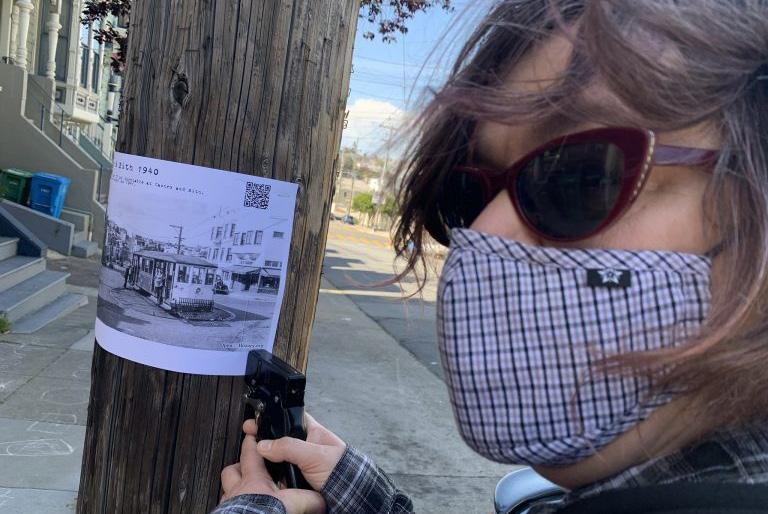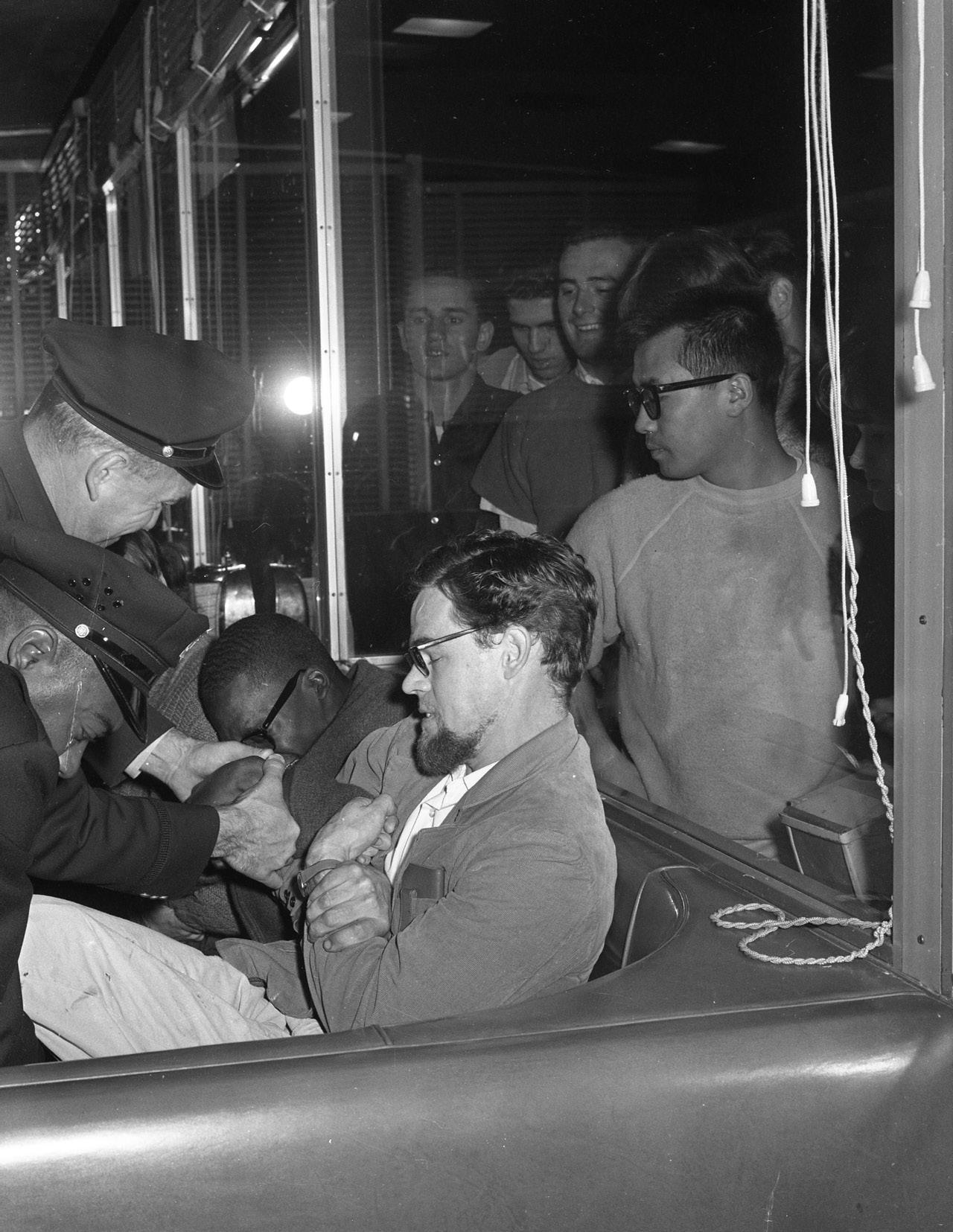
10 minute read
The Sit-In at Mel’s Drive-In
Police begin to forcibly remove protestors inside Mel’s Drive-In as supporting picketers watch from outside on November 3, 1955. (Photo by Fred Pardini, San Francisco Examiner Collection, Courtesy of a Private Collector / wnp28.3199)
by Nicole Meldahl
Advertisement
Some have cautioned us that contemporary issues of social justice and civil rights, surfaced most recently by the Black Lives Matter Movement, have no relevance to west side history work. But it’s always been our mission to uncover overlooked stories, and we’re constantly reminded that history happens in the least likely of places. Case-in-point: Mel’s Drive-In at 3355 Geary Boulevard near Beaumont on the edge of the Richmond District.
As the Civil Rights Movement gained momentum in the South, the fight for Civil Rights in the San Francisco Bay Area found its way to a hamburger emporium in the Outside Lands. Local demonstrations targeted discriminatory hiring practices at local businesses, while protests in Alabama and Washington D.C. focused more on desegregation and voting rights. This is why student organizers targeted San Francisco and Berkeley locations of Mels’ Drive-In, co-owned by Mel Weiss and San Francisco Mayoral Candidate Harold Dobbs, in the Fall of 1963.
Many of these protests were covered by San Francisco Examiner photographer Fred Pardini, who was present for a sit-in at Mel’s Drive-In on November 3, 1963. While taking a closer look at a series of his negatives from that night featured on OpenSFHistory, we were astounded by the story that unfolded. Because what began as a peaceful protest to force Weiss and Dobbs to hire more African Americans to public-facing positions had a ripple effect—impacting the Mayoral election, daylighting systemic racism within organized labor throughout the City, and launching subsequent protests that forever changed the hospitality industry in San Francisco. We’re featuring one part of that story here today, and hope you’ll find rest on OutsideLands. org soon.
Arranging The Sit-In
Picketing and sit-ins of Mel’s DriveIn locations in San Francisco and Berkeley were coordinated by the Ad Hoc Committee to End Discrimination in October 1963. This newly-formed group included members of the Student Non-Violent Coordinating Committee (SNCC), the Congress of Racial Equality (CORE), Youth for Jobs, and the W.E.B. DuBois Club of San Francisco, which was loosely affiliated with the Communist Party. Almost all participants were young students from U.C. Berkeley and San Francisco State College, although a few self-identified housewives also joined their ranks.
Co-chairs for the demonstrations were 25-year-old Arthur Sheridan of San Francisco and 23-year-old Mike Myerson, former president of a U.C. Berkeley student organization founded in 1958 called SLATE. They began by recruiting participants, driving through the Fillmore District and announcing their plans by loudspeaker. Then, the picketing of restaurant locations coincided with protests outside the home of co-owner Harold Dobbs at 1601 Monterey Boulevard near St. Francis Wood on November 2, 1963.
November 3, 1963
The next day, a co-ed group filled all empty booths and counter stools in a peaceful sit-in that started at 4:15pm at the Mel’s Drive-In location at 3355 Geary Boulevard. Demonstrators inside the diner sang “We Shall Overcome” while clapping and pounding on tabletops as picketers chanted outside. Manager Jack Everett went table-to-table asking each “customer” if they wanted to order, but, aside from one group that asked for a cup of tea and six straws, no one wanted a thing. Everett called the San Francisco Police Department.
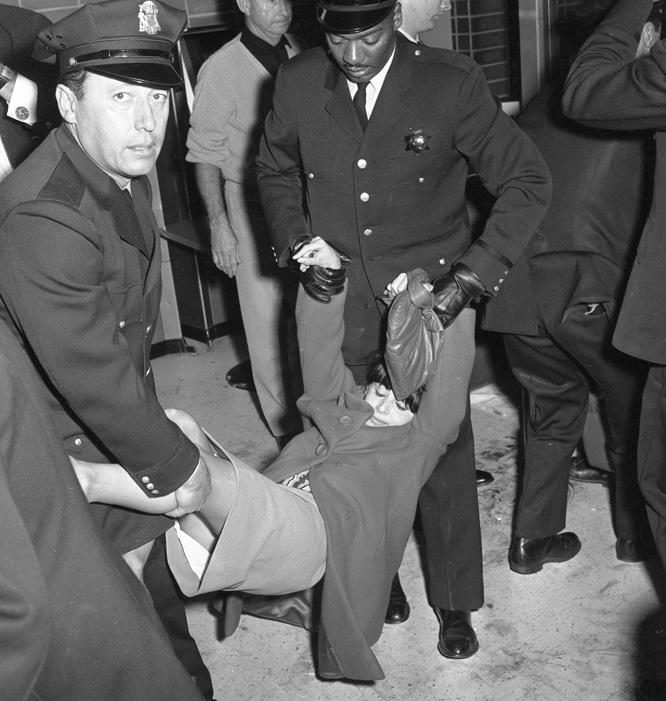
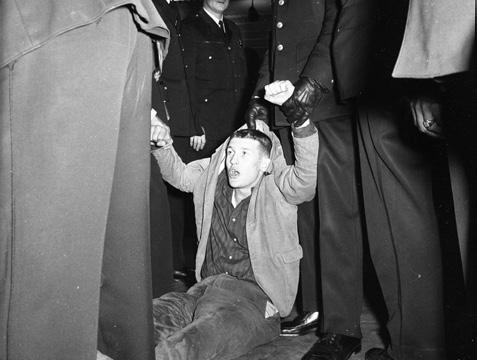
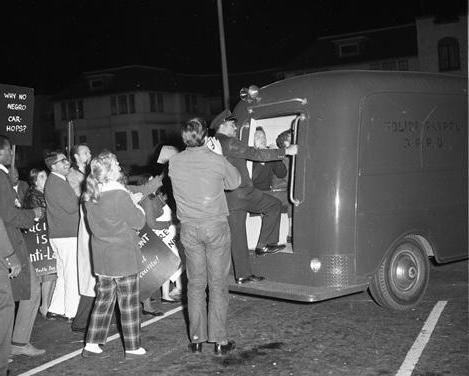
The police arrived with paddy wagons and Fred Pardini was in the middle of the action with his camera. One by one, officers arrested individual protesters who refused to budge. Using textbook nonviolent resistance tactics, they linked arms and let their bodies go limp as they continued to sing. It took a dozen officers more than half-an-hour to pry everyone apart and literally drag them out of the diner. And Pardini captures the paradox of race in America, as African American policemen remove white protestors who seem roughly the same age.
In particular, it took three officers to handle one 26-year-old law student named Terence Hallinan, who was there with his brothers. The Hallinan name might be familiar to San Franciscans and not only because Terence recently passed away on January 17, 2020. He was the son of attorney Vincent Hallinan who took on the Market Street Railway and defended labor leader Harry Bridges, among other notable (and infamous) achievements. Terence spent his early youth in-and-out of trouble and was known for frequent fistfights. But he seems to have turned over a new leaf as he became more politically engaged, joining the SNCC in 1963 and spending that summer working on Civil Rights issues in Mississippi.
When he returned to San Francisco he helped to organize the local W.E.B. DuBois Club and joined the Ad Hoc Committee to End Discrimination shortly before the sit-ins began at Mel’s Drive-In. According to the San Francisco Chronicle, “several scuffles broke out” as officers forced demonstrators into paddy wagons. 1 Terence later explained he had lost his temper because the police were “unnecessarily rough” so he and his brethren had to be a little tougher in return. 2 But Hallinan wasn’t roughed up simply because he was a known rabble rouser. Patricia Kouver, a 22-year-old housewife, said she had also been kicked and thrown against the steps of a paddy wagon. One of the arrested San Francisco State students, Anna Weills, said she didn’t necessarily agree with this method of protest, but it just seemed like the only thing they could do. 3 She and the others arrested were taken to Richmond Station and booked on charges of disturbing the peace
and obstructing justice, thereafter transferred to City Prison and the Women’s Prison—singing and chanting all the way. Charles Johnson was booked on an additional charge of defacing city property after scratching “Freedom Now” onto the wall of his jail cell. Another Hallinan, an attorney named Patrick and brother to Terence, announced he would post the $22-perprotester bail since he “should have been with them [but] wasn’t.” 4
Jo Freeman, who was there, later recalled: “That night…the demonstrators held the first mass sit-in of the Bay Area civil rights movement.” 5
The End is the Beginning
This is a much larger story than what unfolds from the OpenSFHistory photographs featured here; a subject fit for multiple volumes that we’ll try to quickly summarize. There was a brief pause in the protests to allow the mayoral election to proceed without disruption that November. Dobbs was defeated and, after facing criticism that
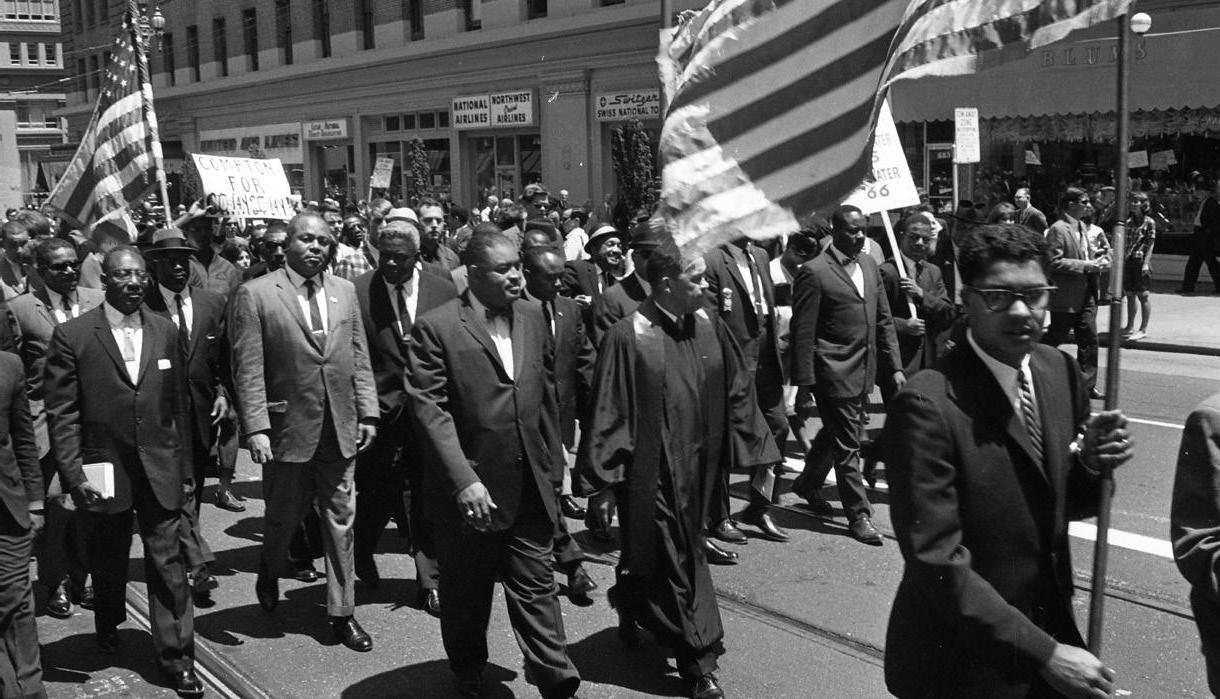
the protests were politically motivated, Arthur Sheridan said, “Now that the election is over perhaps the real issue can come out. And that is simply Negroes in jobs.” 6
The protests resumed at 3355 Geary on November 6th, until Mel Weiss and Harold Dobbs agreed to negotiations. They reached an agreement on November 8th that set up a training school facilitating the promotion of African American employees at all 13 restaurants within the chain, paying them while they learned over a 30-day period.
The battle was won, but the war had just begun. This historic agreement would be contested by Union officials concerned about the sanctity of their negotiated contracts, and in response to complaints from waitresses at Mel’s on Van Ness Avenue who planned to demand protection from “civil rights junk” at union headquarters. 7 David Rubenstein, attorney for the Golden Gate Restaurant Association, also blamed general unrest in the service industry on the Mel’s agreement. The
Left-to-Right Clockwise: Unidentified woman being dragged out of Mel’s Drive-In by numerous police officers on November 3, 1963. (Photo by Fred Pardini, San Francisco Examiner Collection, Courtesy of a Private Collector / wnp28.3200)
Terence Hallinan being dragged out of Mel’s Drive-In by numerous police officers on November 3, 1963. (Photo by Fred Pardini, San Francisco Examiner Collection, Courtesy of a Private Collector / wnp28.3204.
The Human Rights March—including a young John Lewis and Jackie Robinson- -passes the Sheraton Palace Hotel on Market Street near New Montgomery on July 12, 1964. (Photo by Fred Pardini, San Francisco Examiner Collection, Courtesy of a Private Collector / wnp28.2273)
Picketers crowd around arrested protestors as officers load them into a paddy wagon in the parking lot of Mel’s Drive-In on November 3, 1955. (Photo by Fred Pardini, San Francisco Examiner Collection, Courtesy of a Private Collector / wnp28.3207)
The battle was won, but the war had just begun.
Ad Hoc Committee acquiesced to Rubenstein’s demand not to put the agreement into formal writing, satisfied that Weiss and Dobbs had held true to their promise. They considered the matter with Mel’s Drive-In was closed on December 5, 1963, but negotiations with other restaurants would continue the following week.
Demonstrations on the edge of the Richmond District had city-wide impacts. Shortly after beating Harold Dobbs and taking office, Mayor John Shelley would appoint an Interim Committee on Human Relations in early 1964, which recommended the establishment of a permanent Human Rights Commission to the Board of Supervisors. Mandated to address the causes of and problems resulting from prejudice, intolerance, bigotry and discrimination, it was most recently invoked by Mayor London Breed to review controversial statues in Golden Gate Park in June 2020.
Those present at Mel’s on November 3rd and November 6th became seminal figures in the San Francisco Bay Area fight for civil rights that had only just begun. Terry Francois, former president of the San Francisco chapter of the National Association for the Advancement of Colored People (NAACP), soon became first African American named to the Board of Supervisors by Mayor Shelley in 1964. Dr. Thomas Burbridge, then-president of the same NAACP chapter and chairman of the United Freedom Movement, had been a faculty member at U.C. San Francisco since 1956. Working daily with young students, he felt their frustration with the lethargy of the legal system and sympathized with their demands for immediate change. He became an integral voice in the fight for fair hiring practices in San Francisco throughout the 1960s.
Mel’s Drive in at 140 South Van Ness, 1951. (SF Assessors Office Negatives / wnp58.154)

That fight gained momentum as the year went on, with protests marches and additional sit-ins at other restaurants, grocery stores, and hotels not equitably hiring African American employees. The Ad Hoc Committee to End Discrimination next targeted the Sheraton-Palace Hotel with a now historic sit-in that began on March 1, 1964. It was led by Mike Meyerson and 18-year-old Tracy Sims—alumnae of the Mel’s Drive-In protest a few months before.
Sims had recently dropped out of San Francisco State College to focus on civil rights work fulltime. A chairwoman for the Ad Hoc Committee and a secretary for the W.E.B. DuBois Club, she explained why she was involved in the civil rights movement: “I inherited this fight as part of my Negro birthright.” 8
As we look deeper into the history of race on the west side, we seek to discover and share more incredible stories like the sit-in at Mel’s Drive-In. We know we have a lot of ground to cover, but we’re taking it one step at a time. Have a suggestion on what we should tackle next? Email us: nicole@ outsidelands.org. Citations: 1. “A Wild Melee at S.F. Drive-In,” San Francisco Chronicle, Nov. 4, 1963. Newsbank. 2. Ibid. 3. Ibid. 4. Ibid. 5. The Postwar Struggle for Civil Rights: African Americans in San Francisco, 1945-1975 by Paul T. Miller. 6. “Drive Against ‘Fair Housing’,” San Francisco Chronicle, Nov. 7, 1963. Newbank. 7. “Union Row May Snarl Mel’s Pact,” San Francisco Chronicle, Nov. 12, 1963: 8. The Postwar Struggle for Civil Rights: African Americans in San Francisco, 1945-1975 by Paul T. Miller.

